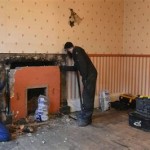Vented vs. Unvented Gas Fireplaces: A Comprehensive Guide
Gas fireplaces have become increasingly popular in homes due to their convenience, efficiency, and aesthetic appeal. However, there are two main types of gas fireplaces: vented and unvented. Understanding the key differences between these two types is crucial to make an informed decision that aligns with your specific needs and preferences.
Vented Gas Fireplaces
Vented gas fireplaces operate by drawing in air from outside through a vent system, burning the gas, and then exhausting the combustion gases through a chimney or flue. This process ensures that harmful pollutants and moisture are removed from the living space, making vented fireplaces a safer and more efficient heating option.
Advantages:
- Safer: Vents remove harmful combustion gases, reducing the risk of carbon monoxide poisoning.
- Efficient: Vented fireplaces use outside air for combustion, maximizing heat output and minimizing energy consumption.
- Moisture control: By venting combustion gases, vented fireplaces help reduce moisture levels in the home.
Disadvantages:
- Installation cost: Installing a vented fireplace requires a chimney or flue, which can be expensive.
- Maintenance: Vents and chimneys need regular cleaning and inspection to ensure proper operation.
Unvented Gas Fireplaces
Unvented gas fireplaces, also known as direct vent fireplaces, operate differently by burning the gas in a sealed combustion chamber. The combustion gases are then vented directly through a wall or roof, eliminating the need for a chimney or flue. Unvented fireplaces offer several advantages, but they also come with some potential drawbacks.
Advantages:
- Lower installation cost: Unvented fireplaces do not require a chimney or flue, making installation more affordable.
- Convenience: Unvented fireplaces can be installed in virtually any location, as they do not require a dedicated venting system.
- Space-saving: Unvented fireplaces do not take up as much space as vented fireplaces, making them suitable for smaller rooms.
Disadvantages:
- Less efficient: Unvented fireplaces use indoor air for combustion, which can reduce heat output and increase energy consumption.
- Moisture release: Unvented fireplaces can release moisture into the living space, potentially leading to condensation and mold growth.
- Safety concerns: Unvented fireplaces must be properly installed to prevent carbon monoxide buildup and ensure adequate ventilation.
Which Type is Right for You?
The choice between a vented and an unvented gas fireplace depends on your individual needs and circumstances. Here are some key factors to consider:
- Safety: If safety is your primary concern, a vented fireplace is the preferred option due to its ability to remove harmful gases.
- Efficiency: Vented fireplaces are more efficient than unvented fireplaces, as they do not use indoor air for combustion.
- Convenience: Unvented fireplaces offer greater installation flexibility and can be more convenient for smaller spaces.
- Budget: Unvented fireplaces are typically less expensive to install than vented fireplaces.
It is recommended to consult with a qualified fireplace professional to determine which type of gas fireplace is right for your home and specific requirements.

Vented Vs Ventless Gas Fireplace Logs

Are Vent Free Gas Fireplaces Safe Ventless

Gas Fireplaces Direct Vent Vs Free Fine Homebuilding

Vented Vs B Vent Direct Free Dixie S

Differences Between Ventless And Vented Fireplaces Factory Buys Direct

Vented Vs Unvented Ventless Gas Fireplace

Vented Vs Ventless Fireplace Explained Finding The Perfect Fit For Y

How To Select And Install A Gas Fireplace Log Set Fireplaces Direct Learning Center

Gas Logs Vented Or Vent Free How To Tell The Difference And Decide Which One You Need
.png?strip=all)
Vented Vs Ventless Gas Logs What S The Difference
Related Posts








